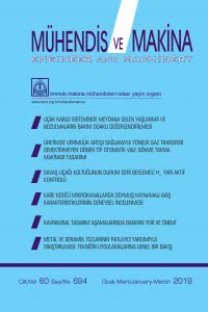Epoksi Esaslı Polimerik Kaplamaların Aşınma Davranışlarının İncelenmesi
Epoksi kaplama, aşınma direnci, pim-disk aşınma, Epoxy coating, wear resistance, pin on disc wear
Investigation of Wear Behaviour of Epoxy-Based Polymeric Coatings
Epoxy coating, wear resistance, pin on disc wear,
___
- Symonds, N., Mellor, B.G. 1999. “Polymeric coatings for impact and wear resistance”, Wear, 225-229, 111-118.
- Xu, Y.M., Mellor, B.G. 2003. “A comparative study of the wear resistance of thermoplastic and thermoset coatings”, Wear, 255, 722-733.
- Xing, X.S., Li, R.K.Y. 2004. “Wear behavior of epoxy matrix composites filled with uniform sized sub-micron spherical silica particles”, Wear, 256, 21-26.
- Kanchanomai, C., Noraphaiphipaksa, N., Mutoh, Y. 2011. “Wear characteristic of epoxy resin filled with crushed-silica particles”, Composites Part B: Engineering, 42, 1446- 1452.
- Shi, G., Zhang, M.Q., Ronga, M.Z., Wetzel, B., Friedrich, K. 2004. “Sliding wear behavior of epoxy containing nano-Al2O3 particles with different pretreatments”, Wear, 256, 1072-1081.
- Li, X., Gao, Y., Xing, J., Wang, Y., Fang, L. 2004. “Wear reduction mechanism of graphite and MoS2 in epoxy composites”, Wear, 257, 279-283.
- Wetzel, B., Rosso, P., Haupert, F., Friedrich, K. 2006. “Epoxy nanocomposites – fracture and toughening mechanisms”, Engineering Fracture Mechanics, 73(16), 2375-2398.
- Kim, S.S., Lee, H.G., Lee, D.G. 2007. “The tribological behavior of polymer coated carbon composites under dry and water lubricating conditions”, Composite Structures, 77 (3), 364-372.
- McCook, N.L., Burris, D.L., Kim, N.H., Sawyer, W.G. 2007. “Cumulative damage modeling of solid lubricant coatings that experience wear and interfacial fatigue”, Wear, 262, 1490-1495.
- Amiriyan, M., Alamdari, H. D., Blais, C., Savoie, S., Schulz, R., Gariépy, M. 2015. “Dry sliding wear behavior of Fe3Al and Fe3Al/TiC coatings prepared by HVOF”, Wear, 342-343, 154-162.
- Srinivas, K., Bhagyashekar, M.S. 2014. “Wear behaviour of epoxy hybrid particulate composites”, Procedia Engineering, 97, 488-494.
- Abenojar, J., Martínez, M. A., Velasco, F., Pascual-Sánchez, V., Martín-Martínez, J. M. 2009. “Effect of boron carbide filler on the curing and mechanical properties of an epoxy resin”, The Journal of Adhesion, 85(4,5), 216-238.
- Bello, J.O., Wood, R.J.K. 2009. “Wireline wear resistance of filled and unfilled polymeric coatings for downhole applications”, Wear, 267, 661-668.
- Basavarajappa, S., Ellangovan, S. 2012. " Dry sliding wear characteristics of glass– epoxy composite filled with silicon carbide and graphite particles", Wear, 296, 491- 496.
- Kumar, V., Sinha, S.K., Agarwal, A.K. 2017. “Tribological studies of epoxy composites with solid and liquid fillers”, Tribology International, 105, 27-36.
- Jakab, B., Panaitescu, I., Gamsjäger, N. 2021. “The action of fillers in the enhancement of the tribological performance of epoxy composite coatings”, Polymer Testing, 100.
- Tahir, N.A.M., Abdollah, M.F.B, Hasan, R., Amiruddin, H. 2016. “The effect of sliding distance at different temperatures on the tribological properties of a palm kernel activated carbon–epoxycomposite”, Tribology International, 94, 352-359.
- Lan, P., Gheisari, R., Meyer, J.L., Polycarpou, A.A. 2018. “Tribological performance of aromatic thermosetting polyester (ATSP) coatings under cryogenic conditions”, Wear, 398-399, 47-55.
- Avilés, M.D., Jiménez N. Saurín, A.E., Carrión, F.J., Sanes, J., Bermúdez, M.D. 2018. “Tribological characterization of epoxy coatings modified with ionic liquids and graphene”, Tribology International, 149.
- Taşyürek, M., Düzcukoğlu, H. 2022. “Epoksi reçinesinin bor karbür takviyeli aşınma davranışının iyileştirilmesi”, İran Polym, 31, 169–184.
- Yalnız, E.T. 2022. “Epoksi Esaslı Polimerik Kaplamaların Tribolojik Özelliklerinin İncelenmesi”, Yüksek Lisans Tezi, Pamukkale Üniversitesi Fen Bilimleri Enstitüsü, Denizli.
- Kan, W.H., Chang, L. 2021. “The mechanisms behind the tribological behaviour of polymer matrix composites reinforced with TiO2 nanoparticles”, Wear, 474-475.
- Medabalimi, S.R., Ramesh, M.R., Kadoli, R. 2021. “Developing partially oxidized NiCr coatings using the combined flame spray and plasma spray process for improved wear behaviour at high temperature”, Wear, 478-479.
- https://www.weicon.com.tr/media/pdf/17/f6/60/TDS_10300005_TR_WEICON_WR.pdf
- https://www.weicon.com.tr/media/pdf/34/75/56/TDS_10150005_TR_WEICON_F.pdf
- ASTM G99-17. 2017. “Standard Test Method for Wear Testing with a Pin-on-Disk Apparatus1”, American Society for Testing and Materials.
- ISSN: 1300-3402
- Yayın Aralığı: 4
- Başlangıç: 1957
- Yayıncı: TMMOB MAKİNA MÜHENDİSLERİ ODASI
Kondenstopların Enerji Verimliliğine Etkileri ve Enerji Maliyet Analizi: Bir Tekstil Firması Örneği
Özgün Bir Baca Gazı Kondenserinin Geliştirilmesi ve Deneysel Olarak İncelenmesi
Celalettin BAKIR, Ahmet YILANCI
Eccentricity in a Horizontal Latent Thermal Energy Storage Unit: Effects of Inner Tube Geometry
Parabolik Oluk Güneş Toplayıcılarının Simülasyonu ve Anlık Isıl Performanslarının İncelenmesi
Abdulvahap YİĞİT, Nurullah ARSLANOĞLU
Epoksi Esaslı Polimerik Kaplamaların Aşınma Davranışlarının İncelenmesi
Elif Tuğçe YALNIZ, Tezcan ŞEKERCİOĞLU, Ahmet Can YILDIZ
Tuğçe ALTINKAYA, Olcay DAĞCI, Fatma Dilay AKSOY, Mehmet Onur BALCI
